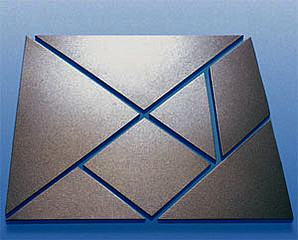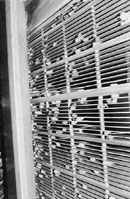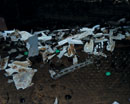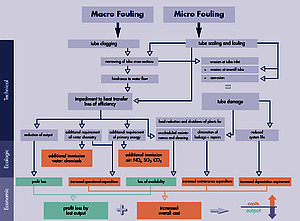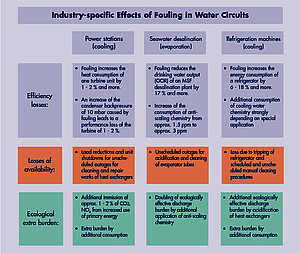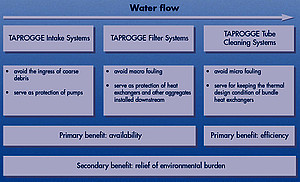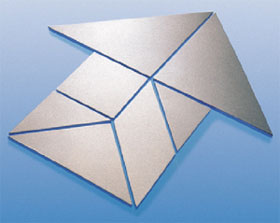Losses of Efficiency and Availability have one Cause: Fouling
The surface waters used in major cooling water circuits or seawater desalination plants contain substances which, depending on location and type of pre-screening system, can significantly vary in both quantity and composition. The undesired deposition of these substances in heat exchangers connected downstream and their piping is designated as fouling. According to its appearance and place of deposition, a distinction is made between macro and micro fouling.
With IN-TA-CT® TAPROGGE offers you all the modular components necessary for the overall solution to your fouling problems. IN-TA-CT® thus effectively and comprehensively prevents losses of efficiency and availability caused by fouling.
To make sure that the benefits created by the IN-TA-CT® modules are permanently preserved, we have established IN-TA-S®, an innovative and very effective service concept that provides all services required for the day-to-day operation of your system - competently and from a single source.
IN-TA-CT® and IN-TA-S® by TAPROGGE.
That's how Macro Fouling damages your System:
Macro fouling is the deposition of macro organisms and other large-particulate inorganic fouling on the tube sheets of heat exchangers and their pipes. They cause obstructions of the heat exchanger tubes whereby the water flow is hindered and damages can occur in the inlet area of the tubes (inlet erosion and tube leakage). Outages due to plant shutdowns for the manual elimination of macro fouling and for repairs are the consequences. This is costly and, moreover, reduces the availability of the operator's plant.
That's how Micro Fouling damages your System:
Micro fouling is the deposition of dissolved and undissolved substances of the cooling water directly on the heat transmission surfaces of the heat exchangers. By this deposition the heat transfer is greatly reduced. Costly losses of thermal efficiency are the consequence. Often several micro fouling mechanisms occur at the same time and intensify. The formation of micro fouling is strongly influenced by tube material (e.g.: increased bio fouling with titanium and stainless steels; corrosion tendency with copper materials, respectively), and cooling water temperature (tendency of hard precipitation).
Fouling in cooling water circuits impairs the efficiency of operators' plants.
Fouling in a conventionally fired power station unit of 500 MW causes turbine performance losses in the range of 5 MW and more, and of even 20 MW in a 1300 MW nuclear power plant unit. In seawater desalination, fouling cuts the Gained Output Ratio (GOR) by high double-digit percentages. Additional consumption of electrical power in compressoroperated refrigeration plants is often in the double-digit percentage range.
Added to that are losses in availability, as well as the avoidable ecological extra burden.
When taking today's competitive conditions into account, and in view of the increasing deregulation of international markets, performance losses in this order are neither acceptable nor can be scoped with. Yet they are reliably avoidable! By TAPROGGE technology.
Day by day, TAPROGGE technology yields thermal performance gains for the operators of more than 12,000 water-technical applications in over 100 countries of the world. At the same time the environmental burden is reduced.
With the application-technological experience from the multitude of these installations TAPROGGE has acquired in its special field, namely the solution to micro and macro fouling problems in water circuits, a key position as competent specialist and market-leading partner of industries worldwide.
By continuous innovation, TAPROGGE has integrated previous single solutions into a closed, overall concept with focussed, harmonized functionality.
IN-TA-CT®
First-class single solutions act even much more effectively by synergetic integration. As a consequence we have developed the integrated IN-TA-CT® System (Integrated TAPROGGE Concept). This system has a modular structure and thereby enables planning that is optimised with regard to requirement and investment. Moreover, IN-TA-CT® offers maximum process safety without interface problems.
IN-TA-S®
IN-TA-CT® is ideally supported by the integrated service system IN-TA-S® (Integrated TAPROGGE Services). IN-TA-S® as well is available in the form of modules and is useful to operators for the realization and optimisation of the efficiency potentials made available by the TAPROGGE technology. The application of both concepts yields maximum efficiency and availability.
